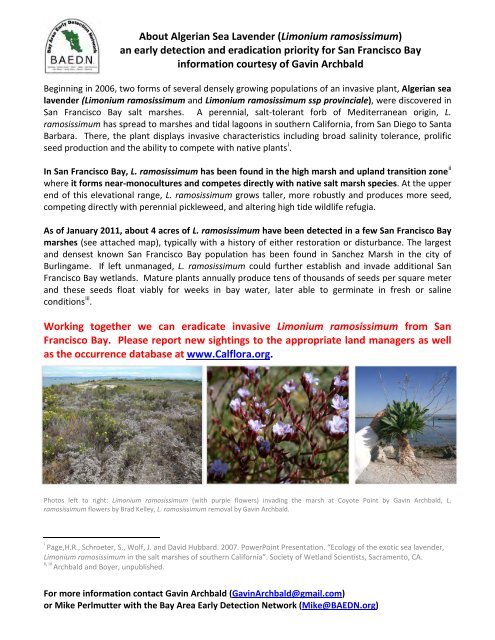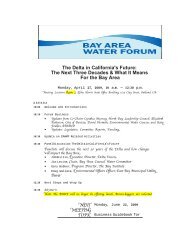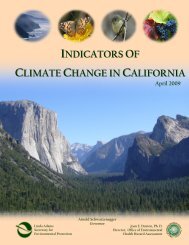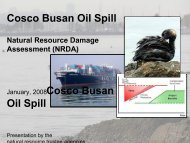About Algerian Sea Lavender (Limonium ramosissimum) an early ...
About Algerian Sea Lavender (Limonium ramosissimum) an early ...
About Algerian Sea Lavender (Limonium ramosissimum) an early ...
You also want an ePaper? Increase the reach of your titles
YUMPU automatically turns print PDFs into web optimized ePapers that Google loves.
<strong>About</strong> <strong>Algeri<strong>an</strong></strong> <strong>Sea</strong> <strong>Lavender</strong> (<strong>Limonium</strong> <strong>ramosissimum</strong>)<br />
<strong>an</strong> <strong>early</strong> detection <strong>an</strong>d eradication priority for S<strong>an</strong> Fr<strong>an</strong>cisco Bay<br />
information courtesy of Gavin Archbald<br />
Beginning in 2006, two forms of several densely growing populations of <strong>an</strong> invasive pl<strong>an</strong>t, <strong>Algeri<strong>an</strong></strong> sea<br />
lavender (<strong>Limonium</strong> <strong>ramosissimum</strong> <strong>an</strong>d <strong>Limonium</strong> <strong>ramosissimum</strong> ssp provinciale), were discovered in<br />
S<strong>an</strong> Fr<strong>an</strong>cisco Bay salt marshes. A perennial, salt-toler<strong>an</strong>t forb of Mediterr<strong>an</strong>e<strong>an</strong> origin, L.<br />
<strong>ramosissimum</strong> has spread to marshes <strong>an</strong>d tidal lagoons in southern California, from S<strong>an</strong> Diego to S<strong>an</strong>ta<br />
Barbara. There, the pl<strong>an</strong>t displays invasive characteristics including broad salinity toler<strong>an</strong>ce, prolific<br />
seed production <strong>an</strong>d the ability to compete with native pl<strong>an</strong>ts i .<br />
In S<strong>an</strong> Fr<strong>an</strong>cisco Bay, L. <strong>ramosissimum</strong> has been found in the high marsh <strong>an</strong>d upl<strong>an</strong>d tr<strong>an</strong>sition zone ii<br />
where it forms near-monocultures <strong>an</strong>d competes directly with native salt marsh species. At the upper<br />
end of this elevational r<strong>an</strong>ge, L. <strong>ramosissimum</strong> grows taller, more robustly <strong>an</strong>d produces more seed,<br />
competing directly with perennial pickleweed, <strong>an</strong>d altering high tide wildlife refugia.<br />
As of J<strong>an</strong>uary 2011, about 4 acres of L. <strong>ramosissimum</strong> have been detected in a few S<strong>an</strong> Fr<strong>an</strong>cisco Bay<br />
marshes (see attached map), typically with a history of either restoration or disturb<strong>an</strong>ce. The largest<br />
<strong>an</strong>d densest known S<strong>an</strong> Fr<strong>an</strong>cisco Bay population has been found in S<strong>an</strong>chez Marsh in the city of<br />
Burlingame. If left unm<strong>an</strong>aged, L. <strong>ramosissimum</strong> could further establish <strong>an</strong>d invade additional S<strong>an</strong><br />
Fr<strong>an</strong>cisco Bay wetl<strong>an</strong>ds. Mature pl<strong>an</strong>ts <strong>an</strong>nually produce tens of thous<strong>an</strong>ds of seeds per square meter<br />
<strong>an</strong>d these seeds float viably for weeks in bay water, later able to germinate in fresh or saline<br />
conditions iii .<br />
Working together we c<strong>an</strong> eradicate invasive <strong>Limonium</strong> <strong>ramosissimum</strong> from S<strong>an</strong><br />
Fr<strong>an</strong>cisco Bay. Please report new sightings to the appropriate l<strong>an</strong>d m<strong>an</strong>agers as well<br />
as the occurrence database at www.Calflora.org.<br />
Photos left to right: <strong>Limonium</strong> <strong>ramosissimum</strong> (with purple flowers) invading the marsh at Coyote Point by Gavin Archbald, L.<br />
<strong>ramosissimum</strong> flowers by Brad Kelley, L. <strong>ramosissimum</strong> removal by Gavin Archbald.<br />
i Page,H.R., Schroeter, S., Wolf, J. <strong>an</strong>d David Hubbard. 2007. PowerPoint Presentation. “Ecology of the exotic sea lavender,<br />
<strong>Limonium</strong> <strong>ramosissimum</strong> in the salt marshes of southern California”. Society of Wetl<strong>an</strong>d Scientists, Sacramento, CA.<br />
ii, iii<br />
Archbald <strong>an</strong>d Boyer, unpublished.<br />
For more information contact Gavin Archbald (GavinArchbald@gmail.com)<br />
or Mike Perlmutter with the Bay Area Early Detection Network (Mike@BAEDN.org)
<strong>About</strong> <strong>Algeri<strong>an</strong></strong> <strong>Sea</strong> <strong>Lavender</strong> (<strong>Limonium</strong> <strong>ramosissimum</strong>)<br />
<strong>an</strong> <strong>early</strong> detection <strong>an</strong>d eradication priority for S<strong>an</strong> Fr<strong>an</strong>cisco Bay<br />
There are four <strong>Limonium</strong> taxa in S<strong>an</strong> Fr<strong>an</strong>cisco Bay marshes<br />
Two non-native invasives:<br />
<strong>Limonium</strong> <strong>ramosissimum</strong> ssp.<br />
provinciale (<strong>Algeri<strong>an</strong></strong> sea lavender)<br />
<strong>Limonium</strong> <strong>ramosissimum</strong> (<strong>Algeri<strong>an</strong></strong> sea<br />
lavender)<br />
Photo by Gavin Archbald<br />
Non-native ornamental<br />
<strong>Limonium</strong> perezii perezii<br />
(C<strong>an</strong>ari<strong>an</strong> (C<strong>an</strong>ary or Perez’s sea sea lavender)<br />
Photo by Gavin Archbald<br />
Native<br />
<strong>Limonium</strong> californicum<br />
(California sea lavender or marsh Rosemary)<br />
Note larger, more<br />
spatulate-shaped<br />
leaves th<strong>an</strong> both<br />
forms of L.<br />
<strong>ramosissimum</strong>.<br />
Note more open<br />
inflorescence <strong>an</strong>d<br />
smaller flowers as<br />
compared to L.<br />
perezii.<br />
Photo by Gavin Archbald<br />
Photo by Mike Perlmutter<br />
For more information contact Gavin Archbald (GavinArchbald@gmail.com)<br />
or Mike Perlmutter with the Bay Area Early Detection Network (Mike@BAEDN.org)






